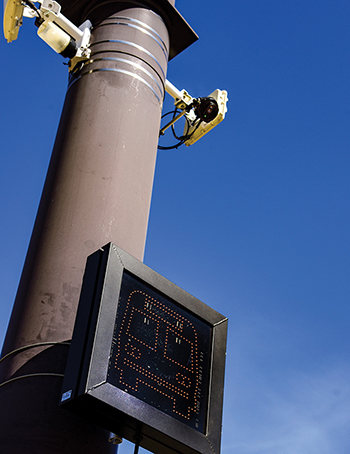Ensuring connected-automated vehicle technology benefits pedestrians, bicyclists and other vulnerable road users is vital to transforming our transportation system in a way that meets the needs of all users.
Aiming for zero traffic deaths by the mid-century mark, the Texas Department of Transportation’s (TxDOT’s) Enhance Safety goal “promotes safe driving, bicycling and pedestrian activities.” TxDOT is conducting projects aimed at meeting that goal, such as Automated Vehicle/Connected Vehicle (AV/CV) Test Bed to Improve Transit, Bicycle, and Pedestrian Safety. The project, conducted by the Texas A&M Transportation Institute (TTI), focuses on reducing crashes involving pedestrians and bicyclists at signalized intersections.

“The project enhances safety by alerting pedestrians and bicyclists to turning buses,” explains TTI Executive Associate Director Katie Turnbull, principal investigator. “Intersections are one of the busiest places where multiple modes interact — and, thus, potentially dangerous places for travelers.”
The multiyear project included three phases. In Phase 1, TTI researchers held meetings, workshops and roundtable forums with stakeholders to identify safety concerns. In Phase 2, the research team designed, developed and pilot-tested a Smart Intersection at The Texas A&M University System’s RELLIS Campus. The system tracks buses as they approach an intersection and warns pedestrians and bicyclists that a bus is about to turn. Researchers also examined innovative approaches being tested throughout the United States and around the world to address these concerns.
Here’s the way it works: a bus communicates with traffic signal equipment regulating an intersection via dedicated short-range communication (DSRC) frequencies. Cameras and sensors monitor the sidewalk at the point of crossing to determine if pedestrians or bicyclists are present. If they are, a supplemental bus sign with the image of a bus lights up above the standard crossing signal, and an audible warning “Caution, Bus Turning” indicates a bus is about to turn.

“We tested possible alternative methods and messages with transit users in Houston,” Turnbull says, “including individuals with hearing and sight limitations. All groups favored multi-alert methods and simple messages. The redundancy also reinforces that tried-and-true strategy for staying safe — look and listen before you cross the street.”
Phase 3 focuses on demonstrating the technology under real-world conditions at the George Bush Drive and Penberthy Boulevard intersection on the Texas A&M University campus. Buses operating along Route 8 — named the Howdy Route by Texas A&M — turn left from Penberthy onto George Bush.
“This final phase of the project provides the opportunity to demonstrate the system in daily operations,” says TTI Research Engineer Srinivasa Sunkari, who oversees the technical side of the project. “We’ve received strong support from the City of College Station, which owns and operates the traffic signals, as well as Texas A&M Transportation Services, which owns and operates the buses.”
Texas A&M Transportation Services installed DSRC radios on 10 buses operating on the Howdy Route. The City of College Station installed the supplemental bus sign, DSRC receivers, sensors and other technologies on the traffic signal poles, and allowed placement of additional equipment in the traffic control cabinets. The system remains separate from normal signal operations.
“This three-phase innovative project highlights the importance of multiple agencies working together to improve safety for all road users,” notes TxDOT Research Project Manager Wade Odell. “Diverse stakeholders have participated throughout all phases of the project, which is needed to help meet TxDOT’s goal of zero traffic fatalities by 2050.”
The eight-month demonstration of the system continues through October 2020. The project will conclude in early 2021 with a stakeholder workshop reviewing the demonstration and other activities.
“We will assess the technical operations of the system,” says Turnbull, “as well as survey pedestrians, bicyclists and bus operators to gauge their perceptions and reactions. The results will help with potential ongoing operations and additional applications.”

